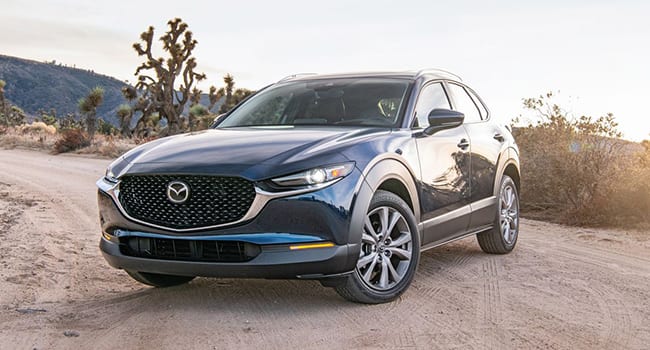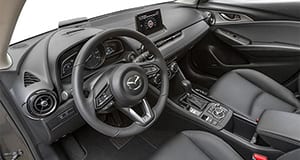
Offered in three basic versions, the CX-3 is powered by Mazda’s SkyActiv 2.0-litre four-cylinder engine that, in this configuration, develops just under 150 horsepower
 For the first time in a long while, I went to a social event last week. Just a few people getting together to play a little music and socially un-distance for a while. It was all COVID-19-proof, of course, and a good time was had by all.
For the first time in a long while, I went to a social event last week. Just a few people getting together to play a little music and socially un-distance for a while. It was all COVID-19-proof, of course, and a good time was had by all.
But what struck me as I pulled up was that out of five vehicles there, four were compact SUVs – Honda CR-V, Hyundai Tucson, Nissan Rogue and Toyota RAV4.
It’s an extremely unofficial random sampling, I realize, but it’s a pretty accurate snapshot of the popularity of these vehicles in Canada.
And right in the thick of it was the 2020 Mazda CX-3 GT I was test driving. It’s a little more on the subcompact side but it’s one of Mazda’s most popular models and one of the top-selling compact SUVs in the country.
Offered in three basic versions, the CX-3 is powered by Mazda’s SkyActiv 2.0-litre four-cylinder engine that, in this configuration, develops just under 150 horsepower.
You can choose from front-drive or all-wheel drive, and transmission choices include a six-speed manual (with the GX only) or six-speed automatic with a manual shift mode. My tester – an all-wheel-drive GT model – had the latter gearbox and I was happy to discover that it was not a continuously variable transmission (CVT).
The CX-3 is arguably the most driveable of Mazda’s sport utility triumvirate, although it could definitely use a little more power.
The problem is that although it behaves itself, the engine in the CX-3 doesn’t seem to be robust enough for this vehicle. It’s responsive and willing, but on long mountain grades, for example, it really has to work. The automatic gearbox is continually kicking up and down to maintain vehicle speed. This engine’s forte is definitely urban schlepping as opposed to long-haul touring.
But it is thrifty. According to Mazda, it will average around 7.5 litres/100 km combined fuel economy rating, which isn’t bad.

Equipment level in my GT model was high, with all the usual conveniences and safety features – steering wheel paddler shifters, pedestrian detection, radar cruise control, rearview camera, heated seats, heated steering wheel, etc., etc – all coming standard.
Mazda puts rear cargo capacity at 1,209 to 1,147 litres (42.6 to 40.5 cubic feet) with the back seat folded down. That isn’t much – less than the Honda HR-V, for example. And my standard test for storage – a full drum kit – just about filled the CX-3 to max.
This is not a trailer-hauling, lumber-carrying SUV meant to double as a weekend work vehicle. This is a fun-to-drive, reasonably versatile sport cute.
It’s a little twitchy at highway speed, but around town it’s nimble, easy to manoeuvre and simple to park. It’s arguably the most entertaining-to-drive SUV in Mazda’s stable.
Equipment level in my GT model was high, with all the usual conveniences and safety features – steering wheel paddler shifters, pedestrian detection, radar cruise control, rearview camera, heated seats, heated steering wheel, etc., etc – coming standard. My tester also had leather interior and glitzy “gunmetal” 18-inch alloy wheels.
Mazda utilizes a centre console arrangement for radio volume control, band choice and station source. Finding another station, for example, involves dialing in the radio and then scrolling along until you find the tuner, and then dialing in the station.
Yes, there are presets but the whole setup is unnecessarily cumbersome. I got used to it after a while but sound system and switch gear ergonomics is one of the most irritating features on today’s breed of fully computerized, driver-interface automobiles and the CX-3 setup is still kind of a pain in the butt.
2020 Mazda CX-3
Engine: 2.0-litre four-cylinder
Transmission: Six-speed automatic
Drive: front-wheel or all-wheel
Horsepower: 148 at 6,000 rpm
Torque: 146 foot pounds at 2,800 rpm
Base price: $31,045
Fuel economy: 8.6 litres/100 km city and 7.4 highway, with regular gas
Some alternatives: Honda HR-V, Ford Escape, Nissan Juke, Hyundai Tucson, Nissan Qashqai, Chevrolet Trax, Hyundai Kona, Kia Niro, Buick Encore, Toyota RAV4.
Ted Laturnus writes for Troy Media’s Driver Seat Associate website. An automotive journalist since 1976, he has been named Canadian Automotive Journalist of the Year twice and is past-president of the Automotive Journalists Association of Canada (AJAC).
The views, opinions and positions expressed by columnists and contributors are the author’s alone. They do not inherently or expressly reflect the views, opinions and/or positions of our publication.

